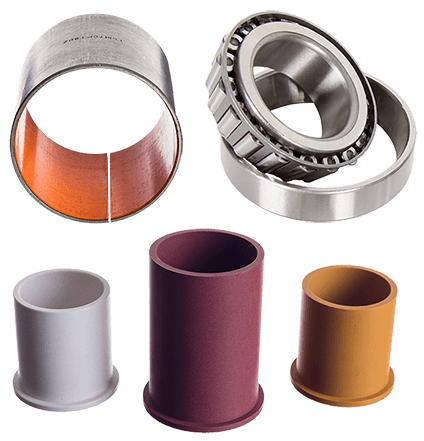Fascination About Volution Bearing
Table of ContentsAbout Volution BearingThe Definitive Guide to Volution BearingThe Volution Bearing StatementsGet This Report on Volution Bearing
An axial (or thrust) bearing lots is when force is alongside the axis of the shaft. A radial bearing lots is when force is vertical to the shaft. Then a combination bearing load is when parallel and vertical forces generate an angular force family member to the shaft. Round bearings are developed with round rounds and can disperse tons over a medium-sized surface area.Below is a quick referral for the kind of bearing lots and the very best round bearing for the task: Radial (vertical to the shaft) and light loads: Select radial round bearings (additionally referred to as deep groove round bearings). Radial bearings are several of the most common kinds of bearings on the marketplace.
Roller bearings are designed with round rollers that can distribute loads over a larger surface location than sphere bearings. Below is a quick referral for the kind of bearing tons and the ideal roller bearing for the job: Radial (perpendicular to the shaft) lots: Select typical cylindrical roller bearings Axial (thrust) (parallel to the shaft) loads: Select cylindrical thrust bearings Combined, both radial and axial, loads: Select a taper roller bearing The rotational speed of your application is the next variable to look at when picking a bearing.
They execute far better at greater speeds and offer a higher rate array than roller bearings. One reason is that the contact between the rolling aspect and the raceways in a ball bearing is a point rather than a line of call, like in roller bearings. Due to the fact that rolling aspects press into the raceway as they surrender the surface, there is much less surface contortion taking place in the point loads from ball bearings.
What Does Volution Bearing Mean?

If this takes place, a simple and common service is to switch the ball bearing material from steel to ceramic. This keeps the bearing size the same but provides approximately a 25% greater speed rating. Considering that ceramic material is lighter than steel, ceramic spheres create less centrifugal force for any type of offered speed.
One reason is that the rounds are smaller and smaller spheres evaluate less and generate much less centrifugal force when turning. Angular get in touch with bearings additionally have an integrated preload on the bearings which functions with centrifugal pressures to effectively roll the spheres in the bearing. If you are creating a high-speed application, then you'll desire a high-precision bearing, usually within the ABEC 7 precision course.
Volution Bearing Things To Know Before You Get This
High accuracy bearings are trusted for applications that go quick because they ensure excellent ball and raceway interaction.
Some applications, like cutting device spindles, will just enable a small deviation to take place on its turning components. If you are engineering an application similar to this, after that pick a high precision bearing because it will create smaller sized system runouts as a result of the limited tolerances the bearing was produced to. Birthing strength is the resistance to the pressure that causes the shaft to differ its axis and plays a crucial function in reducing shaft runout.

When the angular get in touch with bearings are set up, the offset is removed which creates the balls to press right into the raceway without any kind of outside application force. This is called preloading and the process boosts birthing rigidness even prior to the bearing sees any kind of application pressures.
The Definitive Guide for Volution Bearing
Lubrication develops a film of oil between the rolling element and the bearing raceway that helps avoid friction and overheating. The most usual look at these guys sort of lubrication is grease, which includes an oil with a thickening representative. The thickening representative keeps the oil in position, so it won't leave the bearing.
After the rolling aspect passes by, the oil and thickening agent join back with each other. For high-speed applications, knowing the speed at which the oil and thickener can separate and rejoin is essential. This is called the application or bearing n * dm worth. Before you select a grease, you need to locate your applications ndm worth.
Contrast your ndm worth to the grease's max speed worth, situated on the datasheet. If your n * dm worth is greater than the oil max rate value on the datasheet, after that the oil won't have the ability to supply adequate lubrication and premature failing will take place. An additional lubrication choice for high-speed applications are oil mist systems which mix oil with compressed air and after that infuse it right into the bearing raceway at metered periods.